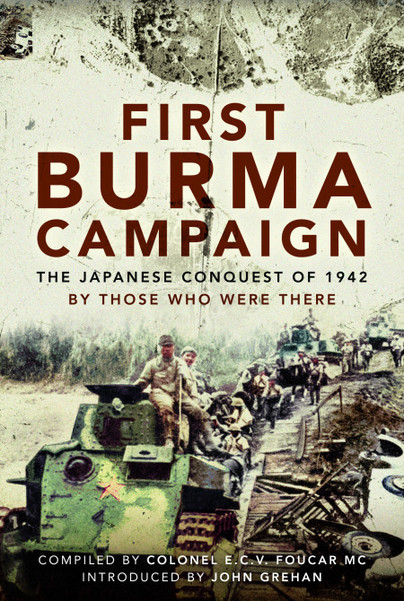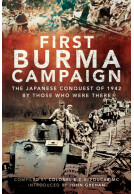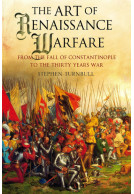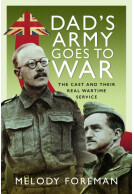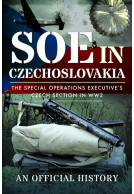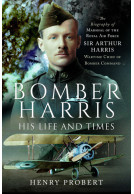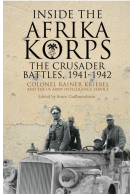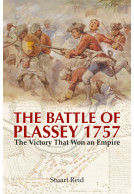First Burma Campaign (Hardback)
The First Ever Account of the Japanese Conquest of 1942
(click here for international delivery rates)
Order within the next 6 hours, 11 minutes to get your order processed the next working day!
Need a currency converter? Check XE.com for live rates
| Other formats available | Price |
|---|---|
| First Burma Campaign Paperback Add to Basket | £16.99 |
| First Burma Campaign ePub (4.6 MB) Add to Basket | £6.99 |
Shortly after the British and Indian forces had withdrawn from Burma in the face of the Japanese onslaught in 1942, Colonel E.C.V. Foucar MC was instructed to undertake a ‘special duty’, namely seek out documentary material and information from the various officers involved in the First Burma Campaign. The final element of Foucar’s task was to write an account of the fighting, based on these many eyewitness accounts, for the Director of Military Training.
This fascinating narrative sets out the challenging geographical, climatic and political conditions the British were faced with in Burma as war became an increasing possibility throughout 1940 and 1941, before turning its attention to the dramatic events when the Japanese launched their ground assault on the country in January 1942.
There followed the ‘Disaster’ at Sittang Bridge, the fateful evacuation of Rangoon, and the march to the River Irrawaddy in an attempt to try and secure the north of Burma and its oilfields. But the loss of Rangoon meant the army was cut off from its supply base and the troops faced starving to death. With the Japanese closing in on the beleaguered British force, the decision was taken to abandon Burma and try to reach India. ‘The odds were we might escape either the Japanese, the failure of our supplies, or the monsoon, but our chances of avoiding all three were slender,’ declared General Alexander. His commander, General Wavell, wrote that, ‘operations were now a race with the weather as with the Japanese and as much a fight against nature as against the enemy’.
Along nothing more than rough country tracks up rugged hills and across rickety bridges constructed only of brushwood or bamboo the ragged, disease-ridden troops battled to reach India just as the monsoons broke. This, one of the most dramatic tales of the Second World War, was first described in detail by Colonel Foucar just after the events described and is now available for all to read.
As noted in a previous review, historians are starting to examine more closely the initial period of the Pacific War, when Japanese was “running wild,” as Admiral Yamamoto would have said. In that vein comes First Burma Campaign: The Japanese conquest of 1942 by Those Who were There (Frontline Books, 2020.) The book was actually written in 1942 by Colonel E. C. V. Foucar, but it’s been compiled by John Grehan for this publication. This is a significant addition to the initial history of the period.
John D. Burtt
Foucar’s story begins with an excellent overview of Burma itself, along with its early history leading up to the 1930s, when the Japanese started getting rowdy. Once it became apparent that Burma was in the gun sites of the Japanese, military preparations – such as they were – are discussed in detail. Suffice it to say, they were inadequate: two regular British battalions at half strength, fourteen battalions of the Burma Rifles and six Frontier Force battalions. Expansion of the latter 20 battalions and milking away of British officers, left the defense force weak and inefficient. They were reinforced in late 1941 with two Indian Brigades and finally one Indian Division. Against this inadequate force, the Japanese would throw four divisions of frontline soldiers.
Defensive air power consisted of a squadron of Blenheim bombers and 16 Brewster Buffalo fighters. More helpful was the American Volunteer Group, more commonly known as the Flying Tigers, armed with P-40 fighters. The AVG was effective, claiming 179 Japanese aircraft shot down, along with 58 destroyed on the ground and another 38 “probables” during the campaign.
Foucar then traces the full campaign in great detail, noting that despite weakness, the Burmese defenders fought aggressively at times, including an attempted raid into Thailand by Frontier Force #2. But there were also repeat scenes from the Japanese advance in Malaya, where the Japanese would show up in unexpected places due to defender’s confusion. The attack on Monywa at the end of April is a good example; the Japanese were able to approach in vehicles, accompanied by tanks, without anyone noticing until the attack was underway. The narrative also includes the operations by Chinese armies in the north as well. While the Chinese provided troops and resistance, they also compounded the problem as the defenders withdrew from line to line, since the Imperial forces wanted to move west to protect India, and the Chinese wanted to go north.
Foucar has provided a very detailed record of the entire campaign, along with extensive orders of battle for the non-Chinese Allies. The book’s major weakness is the lack of maps. There is a single campaign map showing the main Japanese advance columns and main allied withdrawals. But with a narrative as detailed as this one, particularly when mentioning the various states within Burma (like the Shan State) more maps were needed.
The story concludes with a discussion of civil, supply, transportation and medical services throughout the campaign, and a final assessment of the causes for Burma’s conquest. Foucar notes the country had inadequate preparation, poorly trained, almost raw troops, and despite the AVG victories, inadequate air support. The sole positive from the loss was the delay in the Japanese advance that precluded a surge into India because of the Monsoons.
Any student of the campaigns in Burma, including the Chindits and the 1944 U-Go offensive by the Japanese `15th Army and Stillwell’s counterpunch should start their study with this book.
After the British defeat in Burma in 1942 Colonel E.C.V. Foucar was given the job of writing an account of the campaign. Despite the difficulties of piecing together the story from surviving witnesses he succeeded in producing a comprehensive account that does justice to the men who fought in Burma - many of whom died here. It is a dramatic tale that makes as much sense as possible of what was often a very confusing situation.
WW2 Today
This official British military history first became available in published form in 2020 - and is essential reading for anyone interested in the campaign, especially those who had relatives here. Every effort is made to name the different units that were involved in each individual action.
Read the full review here
Featured in
Intelligence and National Security Journal
Featured in WWII History
WWII History
Review by John Burtt
World at War #76
Any student of the campaigns in Burma, including the Chindits and the 1944 U-Go offensive by the Japanese `15th Army and Stillwell’s counterpunch should start their study with this book.
This book provides a view of the 1st Burma Campaign through the eyes of those who were there. The rapid Japanese expansion through Indo China caught the Colonial Nations off guard as they were focussed on the war in Europe. – Very Highly Recommended
Firetrench
Read the full review here
This book is one of those great campaign style books where you are taken through the whole campaign in great detail with fascination. Like the Normandy campaign, this is on a par with that too. I really enjoyed this book as it is written with great detail and care and I would say that this is because it was written by a military man, and would have probably turned out differently had it had a different non-military author. Foucar really know what is needed to get to the full detail, my only slight complaint would be that you can tell the majority of viewpoints were from the officers viewpoint or perspective. A bit more ‘everyday’ soldier opinion would have made it a bit more realistic in my opinion. But despite this, this book is a fascinating and engaging account very well written. The notes and reports section at the back was good to read through and will be enjoyed by those who like the finite detail. A thoroughly good book to read and certainly a must for anyone who enjoys this theatre of war.
UK Historian
⭐⭐⭐⭐⭐
Read the full review here
A gruelling account of a not very well known campaign, I enjoyed the read.
Army Rumour Service (ARRSE)
Read the full review here
Overall, I found this book highly detailed. It covers the history from Army level down to Company level. It describes not only the high level strategic aims and objectives, but it frequently discusses actions at the level of Companies and associated Battalions. The Colonel has conducted some superb research and the ensuing book is exceptionally interesting. It was written shortly after the campaign as a review of the fighting and was aimed at evaluating the Campaign. It is a magnificent assessment, and anyone interested in the Campaign should read this volume – after all it is derived from first-hand accounts and records created at the time.
Dr Stuart C Blank
This is a fascinating and detailed account of a little recognised episode from the Second World War - the attempt by the British, along with Gurhka and Chinese forces - to hold the front in Burma and to repel the Japanese attempt to progress into India. Shortly after the British and Indian forces had withdrawn from Burma in the face of the Japanese onslaught in 1942, Colonel E.C.V. Foucar MC was instructed to undertake a ‘special duty’, namely seek out documentary material and information from the various officers involved in the First Burma Campaign.
NetGalley, Sue Andrews
The campaign was in some ways a failure, as the troops had to withdraw, leaving the Japanese in control. They were hampered by poor supply chains, horrific jungle conditions, some antagonism or lack of c0-operation from the Burmese and struggles between the commanders, especially over who should command the combined forces. However, it did delay the Japanese, holding them in Burma until the monsoon, allowing India time to prepare its defence.
That the men fought bravely was not denied. However, Colonel Foucar does seem to see the events purely from the view of the British officer. He is quite disparaging on occasions about the efforts for the Gurkhas, Indians, Chinese and other natives. He also only records officers as individuals, the rest were just 'the men', and while he credits them with achievements and effort, he does not see them as individuals. However, he was writing as a contemporary, in the accepted style and mindset of that time.
This is a interesting book. Having never heard about this forgotten battle, i was Intrigued to know more. This book extensively explains all the details during and after the battle. It also, prior to the battle details, gives you a good introduction to Burma as a country. Intensive at time, but worth the read for any history buffs.
NetGalley, Kamila Bouvier
A detailed historical account which gives a glimpse of some of the factors and consequences of the conflict between the Japanese and British in Burma in 1942.
NetGalley, Rebecca Kearon-Wiles
About Col E C V Foucar
Born in 1894, during the First World War EMILE CHARLES VICTOR FOUCAR was serving in the London Regiment as a Second Lieutenant when he was awarded the Military Cross, this being announced in The London Gazette on 26 September 1917. After the war, Foucar returned to Burma where he as a lawyer based in Rangoon; he was the fourth generation of his family living in the country. Rejoining the Army in the Second World War, by 1942 had risen to the rank of Colonel. In October that year, he was appointed to a General Staff post for the purpose of assembling the records and writing a narrative of the First Burma Campaign.







